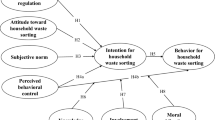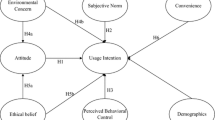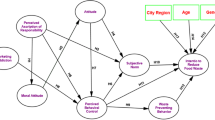Abstract
Household pharmaceutical waste (HPW) contains several antibiotics and hormones, contaminating the environment, wildlife and human beings. Existing literature tends to overlook the determinants of HPW recycling intention, which has practical significance for taking environmental responsibility to minimize HPW and adverse environmental effects. The study adopted Extended Theory of Planned Behavior (TPB) to explore the impact of the key factors on HPW recycling for proposing a more targeted take-back system to solve the problem of difficult recycling. We gathered 459 valid household responses through an online questionnaire survey and employed the PLS–SEM technique to verify the validity and reliability. The results show that subjective norm and recycling attitude directly influences HPW recycling intention, except perceived behavioral control. As for the newly added variables, economic incentive, information publicity, and trust in manufacturers noticeably influence HPW recycling intention, in contrast, the trust in government and retailers is not significant in predicting HPW recycling intention. Furthermore, it is worth noting that information publicity can exert an indirect effect on recycling intention through subjective norms and recycling attitudes. This research provides guidance on increasing the involvement of households in recycling activity for designing and modifying the HPW reverse logistics.
Similar content being viewed by others
Data availability
The data sets generated and/or analyzed during the current study are not publicly available due [the study is funded by NNSFC and HSSFMEC. The data will be used in other research projects] but are available from the corresponding author on reasonable request.
References
Alnahas F, Yeboah P, Fliedel L, Abdin AY, Alhareth K (2020) Expired medication: societal, regulatory and ethical aspects of a wasted opportunity. Int J Environ Res Public Health 17(3):787
Babanyara YY, Ibrahim DB, Garba T, Bogoro AG, Abubakar MY (2013) Poor medical waste management (MWM) practices and its risks to human health and the environment: a literature review. Int J Environ Ealth Sci Eng 11(7):1–8
Ye J, Song Y, Liu Y, Zhong Y (2022) Assessment of medical waste generation, associated environmental impact, and management issues after the outbreak of COVID-19: a case study of the Hubei Province in China. PLoS One 17(1):e0259207
Ilyas S, Srivastava RR, Kim H (2020) Disinfection technology and strategies for COVID-19 hospital and bio-medical waste management. Sci Total Environ 749:141652
Chisholm JM, Zamani R, Negm AM, Said N, Abdel daiem, M. M., Dibaj, M., Akrami, M. (2021) Sustainable waste management of medical waste in African developing countries: a narrative review. Waste Manag Res 39(9):1149–1163
Ariffin M, Zakili TST (2019) Household pharmaceutical waste disposal in Selangor, Malaysia—policy, public perception, and current practices. Environ Manag 64(4):509–519
Kusturica MP, Golocorbin-Kon S, Ostojic T, Kresoja M, Milovic M, Horvat O, Dugandzija T, Davidovac N, Vasic A, Tomas A (2020) Consumer willingness to pay for a pharmaceutical disposal program in Serbia: a double hurdle modeling approach. Waste Manag 104:246–253
Majumder A, Gupta B, Gupta AK (2019) Pharmaceutically active compounds in aqueous environment: a status, toxicity and insights of remediation. Environ Res 176:108542
Blair B, Zimny-Schmitt D, Rudd MA (2017) U.S. news media coverage of pharmaceutical pollution in the aquatic environment: a content analysis of the problems and solutions presented by actors. Environ Manag 60:314–322
Lima ML, Luís S, Poggio L, Aragonés JI, Courtier A, Roig B, Calas-Blanchard C (2020) The importance of household pharmaceutical products disposal and its risk management: example from Southwestern Europe. Waste Manag 104:139–147
He ZG, Li Q, Fang J (2016) The solutions and recommendations for logistics problems in the collection of medical waste in China. Procedia Environ Sci 31:447–456
Najmi A, Kanapathy K, Aziz AA (2021) Exploring consumer participation in environment management: findings from two-staged structural equation modelling-artificial neural network approach. Corp Soc Responsib Environ Manag 28(1):184–195
Chung SS, Brooks BW (2019) Identifying household pharmaceutical waste characteristics and population behaviors in one of the most densely populated global cities. Resour Conserv Recycl 140:267–277
Wei Y, Cui M, Ye Z, Guo Q (2021) Environmental challenges from the increasing medical waste since SARS outbreak. J Clean Prod 291:125246
Insani WN, Qonita NA, Jannah SS, Nuraliyah NM, Supadmi W, Gatera VA, Abdulah R (2020) Improper disposal practice of unused and expired pharmaceutical products in Indonesian households. Heliyon 6(7):e04551
Luo Y, Reimers K, Yang L, Lin J (2021) Household drug management practices of residents in a second-tier city in China: opportunities for reducing drug waste and environmental pollution. Int J Environ Res Public Health 18(16):8544
Nabavi-Pelesaraei A, Mohammadkashi N, Naderloo L, Abbasi M, Chau KW (2022) Principal of environmental life cycle assessment for medical waste during COVID-19 outbreak to support sustainable development goals. Sci Total Environ 827:154416
Chen F, Lou J, Hu J, Chen H, Long R, Li W (2021) Study on the relationship between crisis awareness and medical waste separation behavior shown by residents during the COVID-19 epidemic. Sci Total Environ 787:147522
Liu Z, Wan MD, Zheng XX, Koh SL (2022) Fairness concerns and extended producer responsibility transmission in a circular supply chain. Ind Mark Manag 102:216–228
Lang J, T., (2013) Elements of public trust in the American food system: experts, organizations, and genetically modified food. Food Policy 41:145–154
Dhir A, Malodia S, Awan U, Sakashita M, Kaur P (2021) Extended valence theory perspective on consumers e-waste recycling intentions in Japan. J Clean Prod 312:127443
Xie Y, Breen L (2012) Greening community pharmaceutical supply chain in UK: a cross boundary approach. Supply Chain Manag 17(1):40–53
Yu H, Sun X, Solvang WD, Zhao X (2020) Reverse logistics network design for effective management of medical waste in epidemic outbreaks: Insights from the coronavirus disease 2019 (COVID-19) outbreak in Wuhan (China). Int J Environ Res Public Health 17(5):1770
Martini CL (1993) Medical waste regulation in the United States: a dire need for recognition and reform. Northwest J Int Law Bus 14:206
Insa E, Zamorano M, López R (2010) Critical review of medical waste legislation in Spain. Resour Conserv Recycl 54(12):1048–1059
Begum M, Rivu SF, Hasan M, Al M, Nova TT, Rahman M, Begum R (2021) Disposal practices of unused and leftover medicines in the households of Dhaka metropolis. Pharmacy 9(2):103
Musson SE, Townsend T, Seaburg K, Mousa J (2007) A continuous collection system for household pharmaceutical wastes: a pilot project. J Air Waste Manag Assoc 57(7):828–835
Foon PY, Ganesan Y, Iranmanesh M, Foroughi B (2020) Understanding the behavioural intention to dispose of unused medicines: an extension of the theory of planned behaviour. Environ Sci Pollut Res 27(22):28030–28041
Udofia EA, Gulis G, Fobil J (2017) Solid medical waste: a cross sectional study of household disposal practices and reported harm in Southern Ghana. BMC Public Health 17(1):1–12
Paut Kusturica M, Tomas A, Sabo A (2016) Disposal of unused drugs: knowledge and behavior among people around the world. Rev Environ Contam Toxicol 240:71–104
Ajzen I (1991) The theory of planned behavior. Organ Behav Hum Decis Process 50(2):179–211
Ajzen I (2001) Nature and operation of attitudes. Annu Rev Psychol 52(1):27–58
Lizin S, Dael MV, Passel SV (2017) Battery pack recycling: behaviour change interventions derived from an integrative theory of planned behavior study. Resour Conserv Recycl 122:66–82
Alzubaidi H, Slade EL, Dwivedi YK (2021) Examining antecedents of consumers’ pro-environmental behaviours: TPB extended with materialism and innovativeness. J Bus Res 122:685–699
Savari M, Gharechaee H (2020) Application of the extended theory of planned behavior to predict Iranian farmers’ intention for safe use of chemical fertilizers. J Clean Prod 263:121512
Rathore P, Sarmah SP (2021) Investigation of factors influencing source separation intention towards municipal solid waste among urban residents of India. Resour Conserv Recycl 164:105164
Etale A, Fielding K, Schäfer AI, Siegrist M (2020) Recycled and desalinated water: consumers’ associations, and the influence of affect and disgust on willingness to use. J Environ Manag 261:110217
Dias-Ferreira C, Valente S, Vaz J (2016) Practices of pharmaceutical waste generation and discarding in households across Portugal. Waste Manag Res 34(10):1006–1013
Mahara G, Wu Z, Ge Q, Li Z, Zhang J (2021) Assessment on the impact on human health, environment, water and soil by disposing household expired drugs: a cross-sectional study in China. Risk Manag Healthc Policy 14:1711
Alhamad H, Donyai P (2020) Intentions to “reuse” medication in the future modelled and measured using the theory of planned behavior. Pharmacy 8(4):213
Tong AY, Peake BM, Braund R (2011) Disposal practices for unused medications around the world. Environ Int 37(1):292–298
Akulume M, Kiwanuka SN (2016) Health care waste segregation behavior among health workers in Uganda: an application of the theory of planned behavior. J Environ Public Health 2016:1–8
Tudor TL, Barr SW, Gilg AW (2007) Linking intended behaviour and actions: a case study of healthcare waste management in the Cornwall NHS. Resour Conserv Recycl 51(1):1–23
Mitkidis P, Chrysochou P, Obolevich V, Mitkidis K (2022) Effectiveness of environmental health and loss framing on household pharmaceutical take-back schemes. Waste Manag 143:61–68
Xie Y, Breen L (2014) Who cares wins? A comparative analysis of household waste medicines and batteries reverse logistics systems: the case of the NHS (UK). Supply Chain Manag 19(4):455–474
Hua M, Lai I, Tang H (2019) Analysis of advertising and a points-exchange incentive in a reverse supply chain for unwanted medications in households based on Game Theory. Int J Prod Econ 217:259–268
Liu Z, Li KW, Tang J, Gong B, Huang J (2021) Optimal operations of a closed-loop supply chain under a dual regulation. Int J Prod Econ 233:107991
Xu L, Ling M, Wu Y (2018) Economic incentive and social influence to overcome household waste separation dilemma: a field intervention study. Waste Manag 77:522–531
Mak TMW, Yu IKM, Wang L, Hsu SC, Tsang DCW, Li CN, Yeung T, Zhang R, Poon CS (2019) Extended theory of planned behavior for promoting construction waste recycling in Hong Kong. Waste Manag 83:161–170
Rajapaksa D, Gifford R, Torgler B, Garcia-Valiñas MA, Athukorala W, Managi S, Wilson C (2019) Do monetary and non-monetary incentives influence environmental recycling attitude and behavior? Evidence from an experimental analysis. Resour Conserv Recycl 149:168–176
Knickmeyer D (2020) Social factors influencing household waste separation: a literature review on good practices to improve the recycling performance of urban areas. J Clean Prod 245:118605
Harring N, Jagers SC, Nilsson F (2019) Recycling as a large-scale collective action dilemma: a cross-country study on trust and reported recycling behavior. Resour Conserv Recycl 140:85–90
Loan LTT, Nomura H, Takahashi Y, Yabe M (2017) Psychological driving forces behind household’ behaviors toward municipal organic waste separation at source in Vietnam: a structural equation modeling approach. J Mater Cycles Waste Manag 19:1052–1060
Carfora V, Cavallo C, Caso D, Giudice TD, Devitiis BD, Viscecchia R, Nardone G, Cicia G (2019) Explaining consumer purchase behavior for organic milk: including trust and green self-identity within the theory of planned behavior. Food Qual Prefer 76:1–9
Rompf S, Kroneberg C, Schlösser T (2017) Institutional trust and the provision of public goods: when do individual costs matter? The case of recycling. Ration Soc 29(2):160–178
Townend WK, Cheeseman C, Edgar J, Tudor T (2009) Factors driving the development of healthcare waste management in the United Kingdom over the past 60 years. Waste Manag Res 27(4):362–373
Alshemari A, Breen L, Quinn G, Sivarajah U (2020) Can we create a circular pharmaceutical supply chain (CPSC) to reduce medicines waste? Pharmacy 8(4):221
Peng B, Tu Y, Wei G (2018) Governance of electronic waste recycling based on social capital embeddedness theory. J Clean Prod 187:29–36
Wang H, Zheng L, Xue Q, Li X (2022) Research on medical waste supervision model and implementation method based on blockchain. Secur Commun Netw 2022:1–16
Zheng J, Ma G, Wei J, Wei W, He Y, Jiao Y, Han X (2020) Evolutionary process of household waste separation behavior based on social networks. Resour Conserv Recycl 161:105009
Wang TC, Ku PJ, Lu HL, Hsu KC, Trezise D, Hong YH (2019) Investigation and analysis of medication disposal in hospitals and community pharmacies in Taiwan. Sustainability 12(1):11
Han J (2022) Barcoding drug information to recycle unwanted household pharmaceuticals: a review. Environ Chem Lett 4:1–15
Meng X, Tan X, Wang Y, Wen Z, Tao Y, Qian Y (2019) Investigation on decision-making mechanism of residents’ household solid waste classification and recycling behaviors. Resour Conserv Recycl 140:224–234
Sasu S, Kümmerer K, Kranert M (2012) Assessment of pharmaceutical waste management at selected hospitals and homes in Ghana. Waste Manag Res 30(6):625–630
Si H, Shen L, Liu W, Wu G (2021) Uncovering people’s mask-saving intentions and behaviors in the post-COVID-19 period: evidence from China. Sustain Cities Soc 65:102626
Kumar A (2019) Exploring young adults’ e-waste recycling behavior using an extended theory of planned behavior model: a cross-cultural study. Resour Conserv Recycl 141:378–389
Lan Y, Zhu QH (2009) Analysis and empirical research on the influencing factors of users’ disposition behavior of used appliances. Forecasting 28(1):65–70
Wang Z, Guo D, Wang X, Zhang B, Wang B (2018) How does information publicity influence residents’ behaviour intention around e-waste recycling? Resour Conserv Recycl 133:1–9
Etikan I, Musa SA, Alkassim RS (2016) Comparison of convenience sampling and purposive sampling. Am J Theor Appl Stat 5(1):1–4
Barrett P (2007) Structural equation modelling: adjudging model fit. Personality Individ Differ 42(5):815–824
Rattray J, Jones MC (2007) Essential elements of questionnaire design and development. J Clin Nurs 16(2):234–243
Walters WH (2021) Survey design, sampling, and significance testing: key issues. J Acad Librariansh 47(3):102344
Etter JF, Perneger TV (1997) Analysis of non-response bias in a mailed health survey. J Clin Epidemiol 50(10):1123–1128
Kock F, Berbekova A, Assaf AG (2021) Understanding and managing the threat of common method bias: detection, prevention and control. Tour Manage 86:104330
Fornell C, Larcker DF (1981) Evaluating structural equation models with unobservable variables and measurement error. J Mark Res 18(1):39–50
Hair Jr JF, Sarstedt M, Hopkins L, Kuppelwieser VG (2014) Partial least squares structural equation modeling (pls-sem): an emerging tool in business research. Eur Bus Rev 26(2):106–121
Hair JF, Anderson RE, Tatham RL, Black WC (1998) Multivariate data analysis. Prentice Hall, Englewood Cliffs
Zorpas AA, Dimitriou M, Voukkali I (2018) Disposal of household pharmaceuticals in insular communities: social attitude, behaviour evaluation and prevention activities. Environ Sci Pollut Res 25(27):26725–26735
Tweneboah-Koduah EY, Adams M, Nyarku KM (2020) Using theory in social marketing to predict waste disposal behaviour among households in Ghana. J Afr Bus 21(1):62–77
Mailina R, Zakianis Z (2021) Household medical waste management strategy during the COVID-19 pandemic. Jurnal Ilmiah Kesehatan Sandi Husada 10(2):643–655
Jafarzadeh A, Mahboub-Ahari A, Najafi M, Yousefi M, Dalal K (2021) Medicine storage, wastage, and associated determinants among urban households: a systematic review and meta-analysis of household surveys. BMC Public Health 21(1):1–15
Manga VE, Forton OT, Mofor LA, Woodard R (2011) Health care waste management in Cameroon: a case study from the Southwestern Region. Resour Conserv Recycl 57:108–116
Pakpour AH, Zeidi IM, Emamjomeh MM, Asefzadeh S, Pearson H (2014) Household waste behaviours among a community sample in Iran: an application of the theory of planned behaviour. Waste Manag 34(6):980–986
Funding
This work was supported by National Natural Science Foundation of China (Grant #: 71801003), Humanities and Social Sciences Foundation of the Ministry of Education of China (Grant #: 20YJC630230).
Author information
Authors and Affiliations
Contributions
Author contributions to the present paper are as follows: B-XX and ZL contributed equally to this work, i.e., carried out the data collection, processed the collected data, results were interpreted and finally AR contributed in review, modifications of text and English proofreading of the present manuscript.
Corresponding author
Ethics declarations
Conflict of interest
The authors declare no competing interests.
Ethical approval
An ethical approval or a consent to participate is not applicable for this study. Consent for publication is also not relevant for the same reasons.
Consent to the participate
Not applicable.
Consent to publish
Not applicable.
Additional information
Publisher's Note
Springer Nature remains neutral with regard to jurisdictional claims in published maps and institutional affiliations.
Appendix A
Appendix A
The basic situation of the sample from eight aspects, i.e., Gender, Age, Education, Number of Households, monthly income, average storage time, Types of household medicine, processing method and recycling method.
Rights and permissions
Springer Nature or its licensor (e.g. a society or other partner) holds exclusive rights to this article under a publishing agreement with the author(s) or other rightsholder(s); author self-archiving of the accepted manuscript version of this article is solely governed by the terms of such publishing agreement and applicable law.
About this article
Cite this article
Xu, BX., Liu, Z. & Rustam, A. Application of extended theory of planned behavior to explore household pharmaceutical waste recycling intentions: a case study of China. J Mater Cycles Waste Manag 25, 2870–2886 (2023). https://doi.org/10.1007/s10163-023-01721-9
Received:
Accepted:
Published:
Issue Date:
DOI: https://doi.org/10.1007/s10163-023-01721-9








